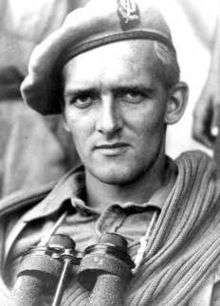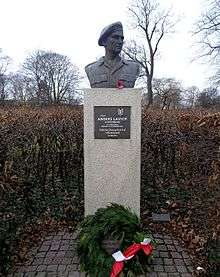Anders Lassen
| Anders Lassen | |
|---|---|
 Anders Frederik Emil Victor Schau Lassen | |
| Born |
22 September 1920 Copenhagen, Denmark |
| Died |
9 April 1945 (aged 24) Lake Comacchio, Italy |
| Buried at | Argenta Gap War Cemetery |
| Service/branch | British Army |
| Years of service | 1940–1945 |
| Rank | Major |
| Commands held |
No. 62 Commando Special Boat Service, Special Air Service |
| Battles/wars | |
| Awards |
Victoria Cross Military Cross & Two Bars |
| Relations | Axel Freiherr von dem Bussche-Streithorst (cousin) |

Anders Frederik Emil Victor Schau Lassen, VC, MC & Two Bars (22 September 1920 – 9 April 1945) was a highly decorated Danish soldier who was the only non-Commonwealth recipient of the British Victoria Cross in the Second World War. He was posthumously awarded the United Kingdom's highest gallantry award for his actions during Operation Roast on 8 April 1945 at Lake Comacchio in Italy in the final weeks of the Italian Campaign.[1][2]
The Danish officer was ordered to lead a raid that would give the impression that a major landing was being undertaken. Lassen fulfilled his mission in the face of overwhelming enemy numbers by single-handedly taking out three enemy positions before being mortally wounded. As his men's lives would be endangered in the withdrawal, he refused to be evacuated from the area.
Military career
Anders Lassen was the son of Emil Victor Schau Lassen and Suzanne Maria Signe Lassen, of Nyhavn, Copenhagen. He was a first cousin of Axel von dem Bussche, a German Resistance member who unsuccessfully tried to kill Adolf Hitler in 1943.[3] While serving in the Danish Merchant Navy, he came to the United Kingdom shortly after the start of the Second World War where he joined the British Commandos in 1940, serving with No. 62 Commando (also known as the Small Scale Raiding Force) as a private. He was commissioned in the field on the General List and awarded an immediate Military Cross for his part in Operation Postmaster the capture of three Italian and German ships from the neutral Spanish colonial island of Fernando Po now known as Bioko, in the Gulf of Guinea.[4]
In early 1943, No. 62 Commando was disbanded and its members dispersed amongst other formations. Lassen was among a number who went to the Middle East to serve in the Special Boat Section, then attached to the Special Air Service.[5] Others joined the 2nd SAS under the command of Bill Stirling, elder brother of David Stirling.[6] During his time in the SBS, Lassen rose in rank to become a Major by October 1944. During his service he fought in North-West Europe, North Africa, Crete, the Aegean islands, mainland Greece, Yugoslavia and Italy. He was awarded two further bars to his Military Cross on 27 September 1943 and 15 February 1944.[7]
On 24 April 1944 he led a successful SBS raid on Santorini, taking out the garrison on the island and blowing up the building housing the radio installation with time bombs. Lassen and the force, with only two casualties, successfully withdrew on two schooners.
Victoria Cross
Lassen, who was 24 years old, was serving as a temporary Major in the British Special Boat Section when he was awarded the Victoria Cross. The citation published in the London Gazette on 4 September 1945 gave the following details:
The KING has been graciously pleased to approve the posthumous award of the Victoria Cross to: Major (temporary) Anders Frederik Emil Victor Schau LASSEN, M.C. (234907), General List. In Italy, on the night of 8/9 April 1945, Major Lassen was ordered to take out a patrol of one officer and seventeen other ranks to raid the north shore of Lake Comacchio. His tasks were to cause as many casualties and as much confusion as possible, to give the impression of a major landing, and to capture prisoners.No previous reconnaissance was possible, and the party found itself on a narrow road flanked on both sides by water. Preceded by two scouts, Major Lassen led his men along the road towards the town. They were challenged after approximately 500 yards from a position on the side of the road. An attempt to allay suspicion by answering that they were fishermen returning home failed, for when moving forward again to overpower the sentry, machinegun fire started from the position, and also from two other blockhouses to the rear.
Major Lassen himself then attacked with grenades, and annihilated the first position containing four Germans and two machineguns. Ignoring the hail of bullets sweeping fire road from three enemy positions, an additional one having come into action from 300 yards down the road, he raced forward to engage the second position under covering fire from the remainder of the force. Throwing in- more grenades he silenced this position which was then overrun by his patrol. Two enemy were killed, two captured and two more machine-guns silenced. By this time the force had suffered casualties and its firepower was very considerably reduced. Still under a heavy cone of fire Major Lassen rallied and reorganised his force and brought his fire to bear on the third position. Moving forward himself he flung in more grenades which produced a cry of " Kamerad ". He then went forward to within three or four yards of the position to order the enemy outside, and to take their surrender. Whilst shouting to them to come out he was hit by a burst of spandau fire from the left of the position and he fell mortally wounded, but even whilst falling he flung a grenade, wounding some of the occupants, and enabling his patrol to dash in and capture this final position.
Major Lassen refused to be evacuated as he said it would impede the withdrawal and endanger further lives, and as ammunition was nearly exhausted the force had to withdraw. By his magnificent leadership and complete disregard for his personal safety, Major Lassen had, in the face of overwhelming superiority, achieved his objects. Three positions were wiped out, accounting for six machine guns, killing eight and wounding others of the enemy, and two prisoners were taken. The high sense of devotion to duty and the esteem in which he was held by the men he led, added to his own magnificent courage, enabled Major Lassen to carry out all the tasks he had been given with complete success.[8]
Lassen is buried at the Argenta Gap War Cemetery grave II, E, 11.[3] His VC medal is on display at the Frihedsmuseet (Museum of Danish Resistance) in Copenhagen, Denmark.
Awards and honours
| 1st Row | Victoria Cross | Military Cross (two bars) | ||||||||||||||||||
|---|---|---|---|---|---|---|---|---|---|---|---|---|---|---|---|---|---|---|---|---|
| 2nd Row | 1939-45 Star | Africa Star | Italy Star | Defence Medal | War Medal 1939–1945 | |||||||||||||||
| 3rd Row | King Christian X Memorial Medal | Greek War Cross[9] | ||||||||||||||||||
Further reading
- Langley, Mike (1988). Anders Lassen, V.C., M.C., of the S.A.S. ISBN 978-0450424922.
- British VCs of World War 2 (John Laffin, 1997)
- Monuments to Courage (David Harvey, 1999)
- The Register of the Victoria Cross (This England, 1997)
- Unge Anders Lassen, (Frithjof Sælen, Bergen, John Griegs Forlag, 1950)
- Anders Lassens krig, 9. april 1940-9. april 1945 (Thomas Harder, København, Information, 2010)
- Anders Lassen – Sømand og soldat (Beretninger samlet af hans moder Suzanne Lassen, København, Gyldendal, 1949/ MeMeMedia, 2000)
- Lewis, Damien (2014). Churchill's Secret Warriors. Quercus Editions Ltd. ISBN 978-1-84866-917-8.
- If I Must Die... : From "Postmaster" to "Aquatint" : Gerard Fournier and Andre Heintz, OREP Editions, 2006. ISBN 2-915762-05-8
References
- Notes
- ↑ Langley, Mike (1988). Anders Lassen, V.C., M.C., of the S.A.S. ISBN 978-0450424922.
- ↑ Combined Ops website
- 1 2 "Casualty details". Commonwealth War Graves Commission. Retrieved 16 June 2010.
- ↑ Richards and Foot, p.93
- ↑ Molinari, Andrea (2007). Desert Raiders: Axis and Allied Special Forces 1940–43. Osprey Publishing. p. 8. ISBN 978-1-84603-006-2.
- ↑ Chappell, Mike (1996). Army Commandos 1940–45. London: Osprey Publishing. p. 48. ISBN 1-85532-579-9.
- ↑ The London Gazette: (Supplement) no. 37476. p. 1048. 9 February 1946. Retrieved 16 June 2010.
- ↑ The London Gazette: (Supplement) no. 37254. p. 4469. 4 September 1945. Retrieved 16 June 2010.
- ↑ "decorations". Anders Lassen Fonden. Retrieved 16 June 2010.
- Bibliography
- Mortimer, Gavin (2013). The Special Boat Squadron in WW2. Osprey. ISBN 1782001891.
- Richards, Brooks; Foot, M R D (2002). Clandestine Sea Operations to Brittany: 1940 – 1944. Routledge. ISBN 0-7146-5316-0.
External links
- Anders Lassen Fonden – The Danish Anders Lassen Foundation
- Photos of Lassen's grave
- Commonwealth War Graves Register Entry for Lassen
- Article on Anders Lassen by Thomas Harder, author of "Anders Lassens krig, 9. april 1940-9. april 1945"